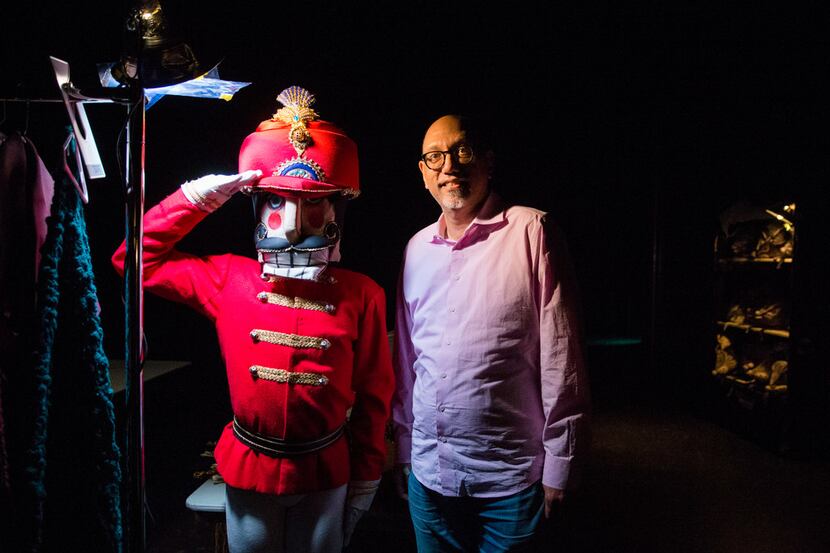Author’s note: Nutcracker season means the beautifully designed, hilariously choreographed version by Texas Ballet Theater artistic director Ben Stevenson is back in Dallas and Fort Worth along with several other first-rate productions, including some featuring national and international ballet stars. For the first time, Avant Chamber Ballet is reviving George Balanchine disciple and former Fort Worth Dallas Ballet artistic director Paul Mejia’s take on the fantasy Christmas story, accompanied by a live orchestra. Two years ago, I overcame my prejudices, learned everything I could about The Nutcracker and checked it out for the first time. Here’s my report, which was initially published on Nov. 30, 2017. Listings for this year’s shows are at the end of the story. - Manuel Mendoza
In three decades of watching dance, I’ve managed to dodge The Nutcracker, the most popular and derided ballet in North American history. Those qualities are connected: many people detest the holiday spectacle, which takes over Christmastime stages coast-to-coast, at least in part because it’s ubiquitous. Dancers are tired of performing it every year. Parents are sick of sitting through it with their children, but for some reason keep going back.
Major ballet companies report deriving upwards of 40 percent of their annual revenue from performances of The Nutcracker. Before the season is over, our region’s top ballet troupe, Texas Ballet Theater, will have rolled out the inescapable “classic” 27 times while dozens of other versions — most produced by ballet schools — once again fill the schedules of local venues.
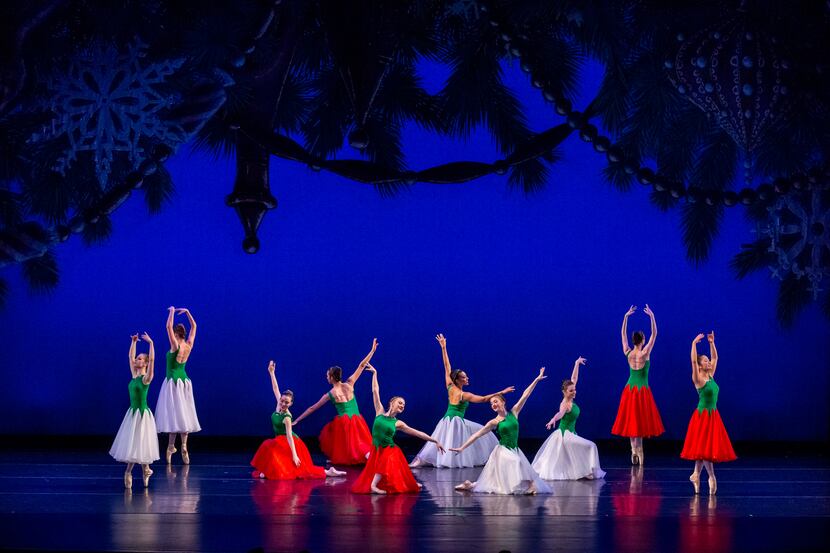
Richardson’s Eisemann Center for the Performing Arts alone hosts no less than five, often back-to-back on the same day. Some of these productions have been around for more than 30 years.
Yet The Nutcracker is only a phenomenon in America and Canada, despite originating in 1892 in Russia, where it was a flop. It didn’t catch on in North America in a big way until the 1960s. But once it did, it never let go.
I decided this was the year to find out what all the fuss has been all about, what I've been missing all these years. Could it grab or repulse me like it has everyone else? (Full disclosure: I saw The Hip-Hop Nutcracker last year, but with its heavily altered plot, break-dancing movement style and use of the Tchaikovsky score only as interludes, it doesn't count.)
Since mid-November, I’ve seen three versions, including TBT’s, and watched New York City Ballet stars Tiler Peck and Tyler Angle bring their considerable skills to the roles of the Sugar Plum Fairy and her Cavalier in Chamberlain Performing Arts’ otherwise student-filled production at the Eisemann.

While I can't say I've unlocked the secret to The Nutcracker's hold on holiday audiences, I can now appreciate the draw of Clara's Christmas Eve trip from her parents' living room to the magical Land of Sweets.
Not my scene
I’m a modern-dance guy. When I started going to dance shows in New York in the 1980s, my punk rock sensibility kept me south of 14th Street and at the Brooklyn Academy of Music’s annual Next Wave Festival, where the avant and the experimental lived.
While no longer proud of these blinders, I still tend to get more excited about contemporary ideas of movement rather than the forms that grew out of court dancing in Italy and France in the middle of the last millennium. Classical ballet seems to me dancing about dancing having nothing to do with how we live, think or move today.
That wasn’t the case at the time The Nutcracker was created.
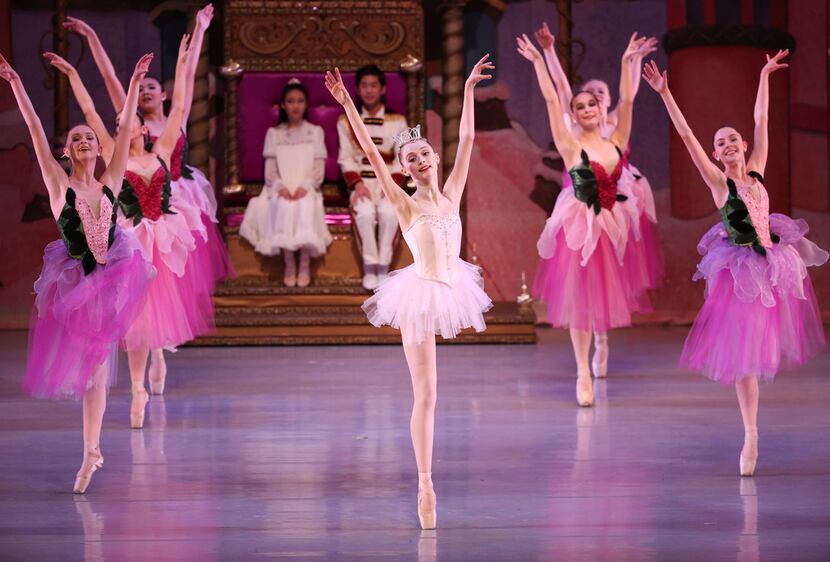
After the success of The Sleeping Beauty, Russia's Imperial Theaters decided to adapt E. T. A. Hoffmann's 1816 story, The Nutcracker and the Mouse King, into a ballet. The production reunited choreographer Marius Petipa and composer Pyotr Tchaikovsky, though Lev Ivanov, Petipa's assistant, had to step in to complete the project when Petipa became ill.
The production was not a hit. Not as dark as Hoffmann's story — kind of like the difference between the The Wizard of Oz novel and its film adaptation — The Nutcracker never became popular outside of North America. And even that took a while.
Shortened versions toured the U.S., and the San Francisco Ballet started performing William Christensen's take in the 1940s, around the time the Disney movie Fantasia used some of the music for a series of Nutcracker-like sequences.
But it wasn't until George Balanchine took a shot with his own version in 1954 that the ballet began to catch on here. A nationally televised TV production later in the decade finally started spreading the idea of The Nutcracker as a potential holiday classic across the continent.
What I found
Like Clara’s, my journey is arduous, beginning with a venture deep into suburbia. This is where local productions with as many as 200 student dancers have proliferated around the ballet schools serving young families in places like Allen, Corinth and Denton.
I head to Avant Chamber Ballet’s truncated version at a Methodist church in Southlake, which seems appropriate for ballet-as-religious-experience. The production takes place on the church’s stage, the pulpit and other worship set pieces pushed to the back.
Artistic director Katie Cooper has designed a one-hour Nutcracker that skips the storytelling to get right to the famous dancing sequences.
It opens with a piano-only rendition of Tchaikovsky’s familiar march, which I realize I’ve heard repeatedly in other contexts. The pianist is later joined by a harpist for the “Angels” number, which features a small group of kids stutter-stepping in long dresses that make it look like they’re gliding. It’s cute.
Unlike almost every other Nutcracker in town, Cooper uses these young amateurs sparingly, relying instead on the professional dancers in her company. Her choreography creates lovely formations out of simple steps as the performers hop, flutter and pose on pointe in eye-pleasing patterns.

Kids are a good third of the audience. A mom behind me keeps whispering to her child, but otherwise it's a polite crowd. At intermission, I find a closer, less distracting pew. From my new perch, I can see a hallway that serves as the wings and begin to notice The Nutcracker as pageant. What stands out is the elaborate, detailed costuming, which as much as anything else makes the ballet a spectacle.
In a traditional production, the first act sets up the plot: A German family is holding a party on Christmas Eve when their daughter’s creepy magician-godfather Herr Drosselmeyer arrives with gifts for her. One of them is a Nutcracker doll that at midnight turns into a full-size prince who whisks Clara away to a pine forest en route to the candy-colored Land of Sweets.
After intermission, it turns into an ethnographic parade that probably couldn’t be conceived in today’s atmosphere of political correctness. These divertissements reduce Spanish, Arabian, Chinese and Russian characters into cultural stereotypes.
The full effect
Texas Ballet Theater’s production at Winspear Opera House, which after closing Sunday, Dec. 3, moves to Fort Worth’s Bass Performance Hall, is my first chance to see the complete show. I attend dress rehearsal only to get photos with Drake Humphreys, who is playing the Nutcracker, leaving after the first act. I’m saving myself for opening night.
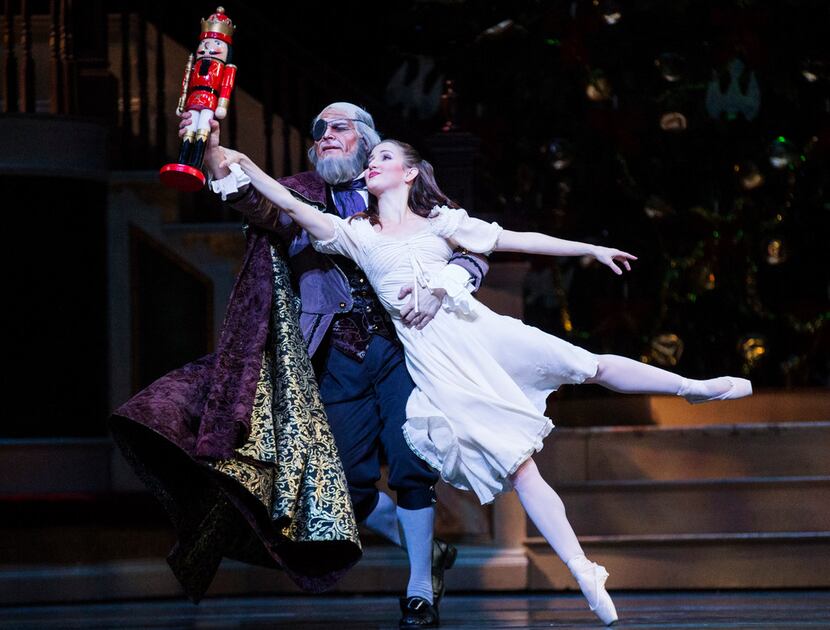
The set is sumptuous, beginning with two colorfully painted curtains, one that re-creates the family living room, the other an establishing shot of the landscape around the house. At the Friday night opening, people are still scurrying to their seats as the overture begins, like the mice who later will do battle with toy soldiers.
There is a lot of precisely choreographed horseplay. TBT artistic director Ben Stevenson is a master of physical comedy, and this will prove to be the most fun part of the evening.
As the family prepares to receive their guests, Clara and her troublemaking brother Fritz, played by youthful looking adult members of the TBT company, shake presents and begin excitedly skipping, hopping and leaping around the stage.
With the innocent, idyllic setting established, humor breaks out as the guests arrive. Two elderly ladies totter toward one another to say hello. A fat family keeps getting in the way. The audience laughs. This couldn’t be more pleasant, despite the heavy amount of mock gunplay as Fritz, his friends and the adult men wield rifles. Arguments and pratfalls create an entertaining realism.

Everything halts with the entrance of eye-patched Drosselmeyer, who is dressed in a glittery Michael Jackson-like getup. His presence triggers a dramatic dimming of the lights, hinting at the darker elements of the Hoffmann story that were toned down for the original production and have never returned. He starts by pulling an incredibly long scarf out of a female guest’s mouth.
Drosselmeyer’s first gift for Clara arrives inside a giant cabbage wheeled on stage: Colombine and Harlequine, human dolls who help fuel further physical hijinks. As they dance mechanically, their limbs get pushed around by Fritz and his friends, knocking down other guests.
This goes on for a while. “Are they finished?” a little girl seated behind me asks. There’s almost as much business in the audience as on stage. The girl and her family sound like they’re unwrapping and smacking their way through an entire meal as the first act progresses.
The production is full of flying and other special effects: the first Angel, looking like a Renaissance Madonna, hovers above the stage dropping glitter. The Christmas tree in the middle of the set grows to ridiculous proportions. And for her trip to the pine forest, where it snows, Clara is whisked into the rafters in a golden swan resembling one of those tacky Jeff Koons sculptures.
With its light, fluttery dancing, the scene is both beautiful and cheesy. The Nutcracker, no doubt, celebrates the hokey, with the fantasy even more ramped up in the second act. The Land of Sweets contains a lot of calories, but I wonder about their nutritional value. Could I get a cavity?
The ethnic divertissements are well-staged and danced, but I don’t find them as compelling as the first act’s humorous and narrative-heavy party scene. Rather that storytelling, this is self-referential dancing that fuels my prejudice against traditional ballet.
That said, the grand pas de deux between the Sugar Plum Fairy and her Cavalier that essentially ends The Nutcracker is quite good, especially when Andre Silva tosses Carolyn Judson every which way in a series of dramatically angled poses. Their technique is impeccable, and when Judson’s head almost hits the floor a couple of times it’s pretty exciting.
What it’s all about
My reaction is flipped when I see Chamberlain Performing Arts’ student-laden production the next afternoon at the Eisemann. The costumes are just as beautiful, but the first-act party can’t match TBT’s clockwork-like shtick. Clara, Fritz and the Snow Queen are played by children, and they are by far the best of the scores of kids on stage. With so many amateurs involved, the choreography is necessarily loose.
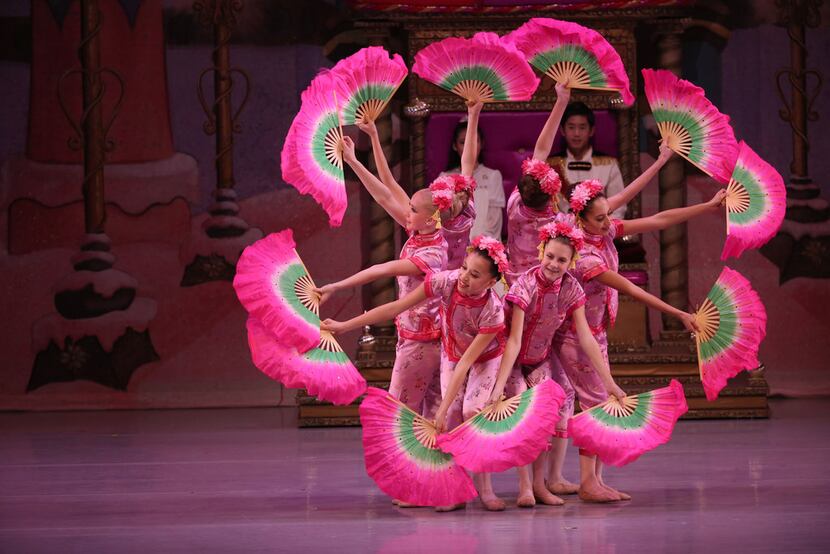
On the other hand, the second-act parade of sweets — bakers, bonbons, candy canes, Spanish chocolate, Arabian coffee and Chinese tea — are a delight because of their sheer numbers. This is what The Nutcracker is all about, why it has become a North American Christmastime staple.
With the opportunity to be part of something big and celebratory, children are introduced to the power of the performing arts.

The icing on the marzipan is the grand pas de deux, danced in Chamberlain’s production by Tiler Peck and Tyler Angle of New York City Ballet. Like other ballet stars, they travel around the country each fall exposing their training and artistry to ballet schools and the masses.
Their duet is from the Balanchine version that led to The Nutcracker becoming an institution and made me wish I had occasionally ventured above 14th Street in my New York days, at least to witness this elevated piece of family entertainment at its finest.
Details
Dallas Ballet Company, Dec. 6-15 at Granville Arts Center, 300 N. Fifth St., Garland. Sold out. dallasballetcompany.org.
Texas Ballet Theater through Dec. 8 at Winspear Opera House, 2403 Flora St., and Dec. 13-29 at Bass Performance Hall, 525 Commerce St., Fort Worth. $25 – $135. texasballettheater.org.
Ballet Ensemble of Texas, Dec. 7-8 at Irving Arts Center, 3333 N. MacArthur Blvd., Irving. $25-$30. balletensembleoftexas.org.
Royale Ballet Dance Academy with Oklahoma City Ballet principal Jonathan Batista as the Cavalier and former Boston Ballet principal Dusty Button as the Sugar Plum Fairy, Dec 7-8 at the Eisemann Center, 2351 Performance Drive, Richardson. $30-$35. eisemanncenter.com.
Dallas Black Dance Theatre’s Espresso Nutcracker, Dec. 13 at the Majestic Theatre, 1925 Elm St. $22.50. dbdt.com.
Dallas Repertoire Ballet, Dec. 13-15 at the Eisemann Center, 2351 Performance Drive, Richardson. $11-$52. eisemanncenter.com.
Festival Ballet of North Central Texas with Marta Petkova and Nikola Hadjitanev of the Sofia Opera and Ballet as guest artists, Dec. 14-15 at Margo Jones Performance Hall at Texas Woman’s University, 1100 Oakland St., Denton. $20-$40. festivalballet.net.
Avant Chamber Ballet in Paul Mejia’s full-length production accompanied by a live orchestra conducted by Brad Cawyer, Dec. 20-22 at Moody Performance Hall, 2520 Flora St., Dallas. $20-$50. avantchamberballet.org.
Allen Civic Ballet with accompaniment from the Allen Philharmonic Orchestra, Dec. 21-22 at the Allen ISD Performing Arts Center, 300 Rivercrest Blvd., Allen. $18-$34. allencivicballet.org.
Tuzer Ballet with Boston Ballet principals Seo Hye Han and John Lam, Dec. 21-22 at the Eisemann Center, 2351 Performance Drive, Richardson. $15-$100. tuzerballet.com.
Collin County Ballet Theatre with Cuban ballet stars Adiarys Almeida and Taras Domitro returning as the Sugar Plum Fairy and the Cavalier and live music by the Plano Symphony Orchestra in the Richardson production only. Dec. 21 at Centennial High School, 6910 Coit Road, Frisco, and Dec. 23-24 at the Eisemann Center, 2351 Performance Drive, Richardson. $25-$87. collincountyballettheatre.com.
